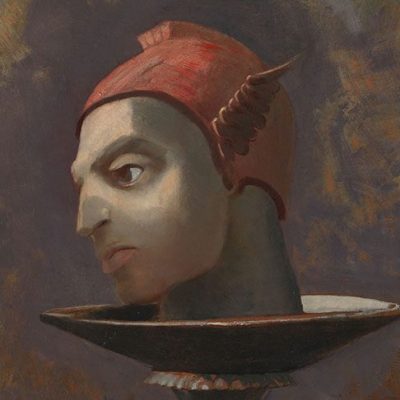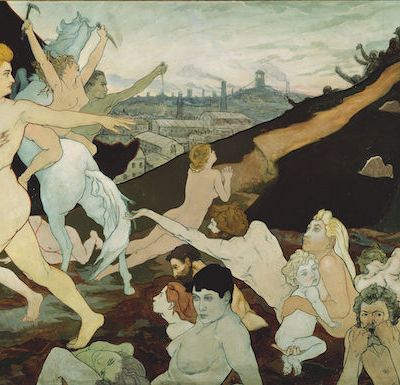When the novelist and critic Joris-Karl Huysmans concluded in 1883 that the work of Odilon Redon was ‘difficult to define’, he made a more precise assessment than such expressions of critical reserve usually permit. This is because difficulty of definition is at once central to Redon’s style, and his preferred subject. Attempting in his journal to explain his aims as an artist, Redon stressed the provisionality of his pictures. Though he was a skilled draughtsman, finish was not his priority. Instead, what he hoped to achieve was a sense of ongoing process, of continuity and possibility. ‘My drawings,’ he writes, ‘inspire without defining themselves. They determine nothing. They take us, just like music, to the ambiguous world of the indeterminate.’ Redon hints that his pictures escape definition not only because they are abstruse, but because they are depictions of processes that are also depictions in progress – like the face emerging out of the radiation and primordial swellings of Face-Germination (1888).
Face-Germination (1888), Odilon Redon

For Huysmans, Redon’s indefinability resulted in an ‘uneasiness’ best pinpointed when Redon’s pictures were imagined in line with other arts. ‘Redon’s forebears,’ Huysmans suggests, ‘are only to be found among musicians, and undoubtedly among poets. It is indeed a true transposition of one art into another.’ This idea has been thoughtfully picked up in an exhibition of Redon’s work at the Kröller-Müller Museum. Drawing on the Kröller-Müller’s own leading collection of Redon’s lithographs, pastels, prints, and paintings, and also borrowing substantially from museums and private collections elsewhere, the exhibition emphasises Redon’s eagerness to reinterpret not only literary texts and music, but also scientific writing and the work of other visual artists.
Oannes (c. 1900–10), Odilon Redon. Kröller-Müller Museum, Otterlo

Redon made a number of albums and individual illustrations to complement musical and literary works, including a set inspired by Edgar Allan Poe and, in 1888, a frontispiece for Huysmans’ novel Against Nature (1884). Perhaps the most famous of these are the multiple sequences he made to illustrate Gustave Flaubert’s frequently revised Temptation of Saint Anthony (1874). The provisionality of Flaubert’s text, as well as the inchoate metamorphoses of the creatures it contains, suited Redon, and one of the figures he returns to most enthusiastically is Oannes, a mythical amphibian. Oannes appears in the albums, but also independently in an eponymous, beautiful late oil (c. 1900–10), which encircles him in a smear suggestive of an uncoiling fish tail, emerging from a cloud of pale pink smoke.
In Flaubert’s text, Oannes claims to have emerged out of ‘the abyss that I might harden matter, and give a law unto forms’ (one of the lithographs illustrates this line). The processes by which forms develop were similarly attractive to Redon, whose Saint Anthony illustrations vary dramatically in their level of detail and finish. A sequence published by Éditions Ambroise Vollard in 1938, more than 20 years after Redon’s death, ranges from the murky detail of Oannes: I, the First Consciousness…, to the clean draughtsmanship of Immediately Appeared Three Goddesses. The final image, Day Appears at Last…and in the Very Disk of the Sun Radiates the Face of Jesus Christ, blends these techniques, showing Christ emerging out of celestial radiance in the process of being limned. His hair, which is naturalistically rendered on top, dwindles to single lines to the side of his face. It is often uncertain in Redon’s work whether clarity should be thought of as an emergent quality or a fugitive one.
Day Appears at Last…and in the Very Disk of the Sun Radiates the Face of Jesus Christ, Odilon Redon, lithograph from The Temptation of Saint Anthony by Gustave Flaubert (Éditions Ambroise Vollard, Paris, 1933–38)

Redon’s lukewarm response to another writer he illustrated, Edward Bulwer-Lytton, provides clues as to the role that music played for him. Reading Bulwer-Lytton’s fiction made Redon wish he were listening to music: ‘Ah! Music is not like this. It is almost universal and crosses all barriers.’ With this in mind, the pictures that this exhibition associates with music are cunningly chosen. While Redon’s more literal representations of music and sound are evident – A Mask Rings the Death Knell (1882) features scratches to depict soundwaves, for instance, and a lithograph published in La Revue wagnérienne in 1885 shows Brunhild – the absence of sound is more striking. Silence (n.d.) and Daydream (1900) invite us to expand our sense of what music might mean to a painter. With their focus on interiority, these works reveal how Redon was drawn to music’s capacity to blend private experience and abstract universality – ‘no colour,’ he writes elsewhere, ‘can translate the musical world which is only and solely internal.’
Daydream (1900), Odilon Redon

In its careful juxtapositions, this exhibition also draws attention to the frequent recurrence of Redon’s favoured motifs, often in wildly different contexts. The composition of Saint Anthony at prayer used on the cover of the Ambroise Vollard edition returns in brilliant pastels as Woman amidst Flowers (n.d.), utterly altering the significance of the image as well as the sex of the figure it depicts. The head of John the Baptist appears countless times, but the pattern of representation Redon establishes through these repetitions returns only slightly altered in his depictions of the heads of Orpheus, Perseus, Christ, and others. Redon portrays Pegasus, familiar symbol of both hybridity and artistic inspiration, in paintings, pastels, lithographs, and material objects – the most exquisite piece in the exhibition is a painted screen with the winged horse emerging from green marbling in its top-right corner.
Redon’s contemporaries often described him as a ‘symphonic painter’, but for Redon (and for this exhibition), music is primarily a structure for thought rather than a source of subject matter. By tracing the thematic echoes, the exhibition makes clear the movement of Redon’s work. Time is constitutive for music, unlike (most) drawing or painting. This exhibition helps show that Redon’s pictures, too, are best understood in the course of their transpositions.
‘Odilon Redon: Literature and Music’ is at the Kröller-Müller Museum, Otterlo, until 9 September.
From the July/August issue of Apollo. Preview and subscribe here.



